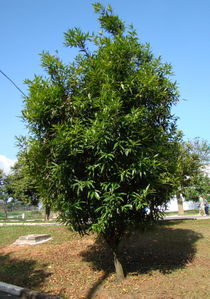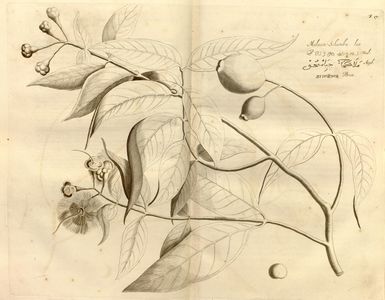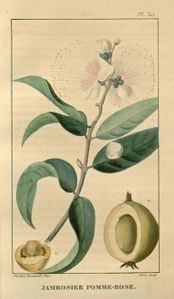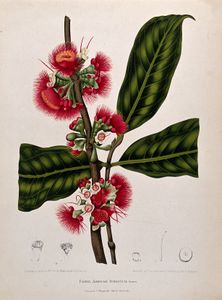Syzygium jambos : Différence entre versions
| (Une révision intermédiaire par le même utilisateur non affichée) | |||
| Ligne 132 : | Ligne 132 : | ||
== Usages == | == Usages == | ||
{{Citation encadré | {{Citation encadré | ||
| − | |texte=Feuillage décoratif. Fleurs à très longues et nombreuses étamines, blanc-jaunâtre, décoratives, malheureusement très caduques et fugaces. | + | |texte=Feuillage décoratif. Fleurs à très longues et nombreuses étamines, blanc-jaunâtre, décoratives, malheureusement très caduques et fugaces. Brise-vents en Dominique. |
|auteur=Rollet, 2010. | |auteur=Rollet, 2010. | ||
}} | }} | ||
| Ligne 156 : | Ligne 156 : | ||
*[http://pfaf.org/user/Plant.aspx?LatinName=Syzygium%20jambos Plants for a future] | *[http://pfaf.org/user/Plant.aspx?LatinName=Syzygium%20jambos Plants for a future] | ||
*[[:en:Syzygium jambos (PROSEA)|PROSEA sur Pl@ntUse]] | *[[:en:Syzygium jambos (PROSEA)|PROSEA sur Pl@ntUse]] | ||
| − | |||
*[https://inpn.mnhn.fr/espece/cd_nom/447411/tab/taxo TAXREF] | *[https://inpn.mnhn.fr/espece/cd_nom/447411/tab/taxo TAXREF] | ||
*[http://tropical.theferns.info/viewtropical.php?id=Syzygium%20jambos Useful Tropical Plants Database] | *[http://tropical.theferns.info/viewtropical.php?id=Syzygium%20jambos Useful Tropical Plants Database] | ||
Version actuelle en date du 27 septembre 2020 à 18:28
Syzygium jambos (L.) Alston
| Ordre | Myrtales |
|---|---|
| Famille | Myrtaceae |
| Genre | Syzygium |
2n = 28, 33, 44, 46, 66 ?
Origine : Asie du Sud-Est
sauvage ou cultivé
| Français | jambosier / jambose |
|---|---|
| Anglais | rose apple |
- fruit comestible cru ou transformé
- fruit distillé : eau de rose
- bois d'œuvre
- bois de feu
- charbon de bois
- médicinal : graines, feuilles, écorce
- ornemental
- arbre d'ombrage
- brise-vent
- mellifère
- écorce : tanin
Sommaire
Description
Noms populaires
| français | jambosier / jambose, pomme-rose ; jambrosade, jamrosat (La Réunion) |
| anglais | rose apple, Malabar plum |
| allemand | Rosenapfel |
| néerlandais | djamboe mawar |
| italien | pomarosa, melarosa |
| espagnol | pomarrosa |
| portugais | jambo, jambo rosa, jambo amarelo |
| arabe | |
| chinois | 蒲桃 - pu tao (Flora of China) |
| sanscrit | |
| hindi | gulabjaman (Wealth of India) |
| bengali | gulabjamb, jamrul (Wealth of India) |
| marathi | gulabjaman (Wealth of India) |
| telugu | jambuneereedu (Wealth of India) |
| tamoul | perunaval, pannirkoyya, sambunaval (Wealth of India) |
| kannada | pannerale (Wealth of India) |
| malayalam | jambavam, malakachampa (Wealth of India) |
| oriya | golabjamli (Wealth of India) |
| Philippines | tampoy (tagalog), bunlaun (bisaya), yambo (PROSEA) |
| Indonésie | jambu air mawar, jambu mawar, jambu kraton (PROSEA) |
| Malaysia | jambu kelampok, jambu mawer (PROSEA) |
| Thaïlande | chomphu-namdokmai (centre), manomhom (nord), yamu-panawa (Malay-Yala) (PROSEA) |
| Vietnam | ly, bô dào, roi (PROSEA) |
| Laos | chièng, kièng (PROSEA) |
| Cambodge | châm'-puu (PROSEA) |
Classification
Syzygium jambos (L.) Alston (1931)
synonyme :
- Eugenia jambos L. (1753)
Cultivars
Histoire
Usages
Feuillage décoratif. Fleurs à très longues et nombreuses étamines, blanc-jaunâtre, décoratives, malheureusement très caduques et fugaces. Brise-vents en Dominique.
Abundantly cultivated in all tropical regions for its edible fruit, also as ornamental or shade tree and wind break. The fruits are eaten raw by children or are stewed as dessert. They are seldom sold in markets because of their lack of a distinct flavour. With lemon juice they are prepared to jam or jelly and more frequently preserved mixed with other fruits, also prepared to sauces and syrup or candied with cinnamon. Bark, leaves and seeds are medicinally used. The bark is sometimes used locally for tanning.
Références
- Boym, Michał, 1696. Flora Sinensis. Paris, 15 p. Seconde édition en français. Voir Giam-bo sur Pl@ntUse.
- Chauvet, Michel, 2018. Encyclopédie des plantes alimentaires. Paris, Belin. 880 p. (p. 496)
- Rollet, Bernard et coll., 2010. Arbres des Petites Antilles. Tome 1 : Introduction à la dendrologie. 276 p. Tome 2 : Description des espèces. 866 p. + 46 pl. coul. + CD de photos sur l'anatomie du bois. Basse-Terre, ONF. Voir sur Pl@ntUse.






